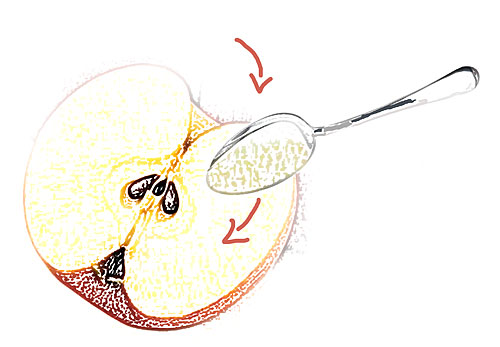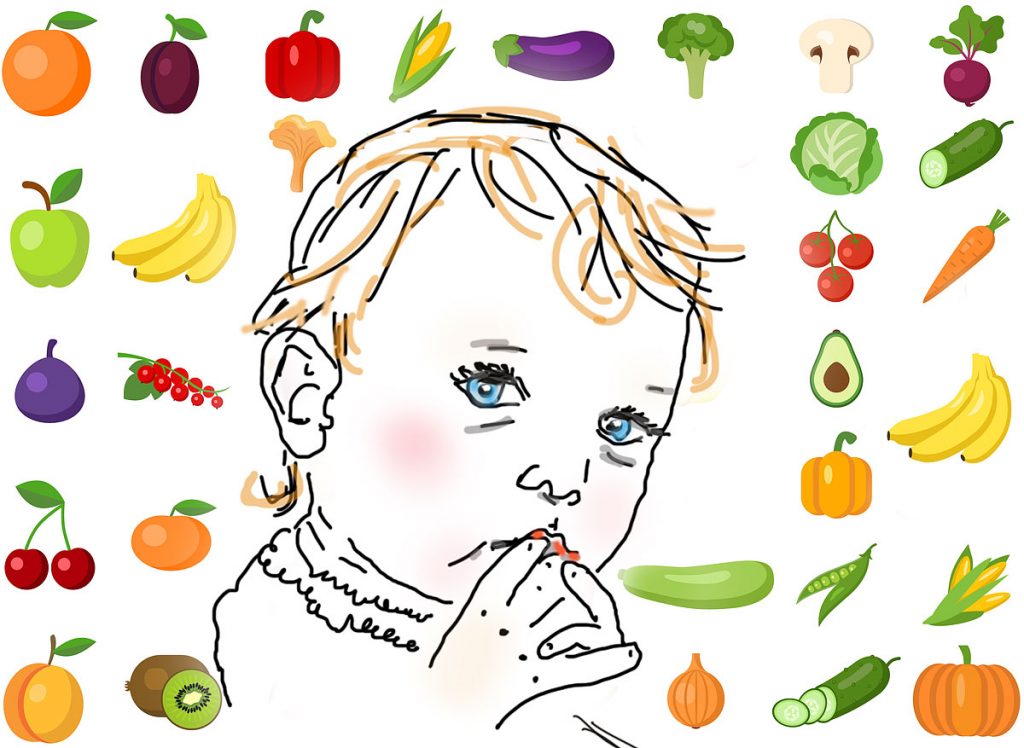Moms have been feeding babies for centuries. Only in the last few decades have pre-made baby foods become the norm. Here you will find suggestions for Baby Led Weaning.
When I had my babies, pediatricians were already advising mothers to make their own food. So that is what I did. Although it was not quite as advanced as some Baby Led Weaning advisors give now, it was rather close. My babies grew up healthy and strong, and in the process, I learned how to prepare nourishing foods during their childhoods.
You are feeding your babies delicious and wholesome home-cooking sets them up for a lifetime of healthy eating.
As a working mom, I had to find ways to prepare many meals ahead of time in those days. I was fortunate to have stories and guidance from my mother’s and grandmother’s day about how moms did things back then. Since so many more conveniences were available then and now even more so, many things make mom’s and dad’s lives easier. The basics are the same, though, and I hope these insights will help you. This blog is about the beginnings, with a few tips and tricks I’ve learned along the way. The following ideas represent things I have learned and practiced along the way, and I hope you find this helpful.
Foods To Feed Your Baby From Four to Twelve Months
When you were a baby, your mother may not have introduced any solid foods before six months of age, which can also be advised these days for baby-led-weaning. This advice is especially relevant to choking hazards. In those days, mothers often started large birth weight babies on pablum or other homemade substitutes as early as four to five months old depending on the child. You know your baby best, so always take your cues from them. The following guidelines are based on prevailing information.

What About Wheat and Foods Containing Gluten?
Until recently, introducing gluten-containing foods into your baby’s diet was considered not a good idea. Especially if there was any evidence of celiac or gluten sensitivity in your family.
A new study by King’s College London says, “Introducing high doses of gluten from four months of age into infants’ diets could prevent them from developing celiac disease, a study has found, though researchers say further studies are needed before being applied in practice.”
New information says the risk of celiac disease in a first-degree relative is only between 5 and 10%. There are other factors involved. Source: If there is a relational risk, asking your doctor for a blood test for a child after three years of age is suggested.
A word of caution about the mention of high doses: the study says that infants were fed only up to four grams of wheat protein per week, beginning at four months old. Although the article advises caution that more studies are requisite for an absolute determination, this can be positive news for many of us living as celiac or gluten sensitives. There are many things to consider when it comes to gluten if there is a susceptibility.
Gluten-Sensitivity or Celiac is more easily managed now. There are many naturally gluten-free foods and grocery products available. If you are looking for gluten-free recipes, try my Gluten-Free, You Can Do It cookbook.
Everything goes into the mouth, so give your baby something good to eat. Start with non-sweet foods so your baby will not be dependent on foods that taste sweet. Continue breastfeeding or formula. No Honey or Sugar before 15 months old. Be cautious of choking hazards and any fruit Pits, Seeds, or bones in meat or fish, etc.*
Tip: Since babies put most things in their mouths at mealtime, dip their fingers in some pureed food, which will get licked off. Fun teething spoons are good also; dip them into a bit of porridge and let your baby put it in their mouth and taste.
An easy-to-clean silicone food-safe mat in the highchair tray will save you lots of time. So many new cute bibs, trays, and utensils help you and your baby has a great time at mealtime.
Remember the old saying, “Food before One, Is Just For Fun…” Babies need breast milk or formula for the first year and sometimes longer. As a general rule, solid foods begin at 6 months of age. Babies born with a higher birth weight may need to start at 4 months. You can tell when your little munchkin wants to start eating solid foods. They will be able to sit up by themselves and start to taste and either enjoy the foods or spit them out. Give it time; babies need time to develop a taste for solid foods; why they even love liver pate at one point if you give them half a chance?
The prepared beef liver is perfect for babies as it is high in iron. My children ate pureed liver pate that I prepared myself as babies. As older children, they would not touch the liver. However, on becoming adults, they suddenly like liver again.
Always start introducing your baby to the vegetables first and the fruits last. It is OK to mix things up, but especially in the beginning, you should try out single foods so if there is any reaction, you know what it was—no need to season or dress up a baby’s first foods. Let them get used to the taste of real food. Boiled or baked sweet potatoes with skins removed are quite delicious just by themselves. As adults, we want butter and maple syrup on them too, but babies don’t need that!
First Foods for Babies, Four to Six Months Old

- Oatmeal Porridge
- White Rice (brown rice can have a type of mold in the polishings that are not good for babies)
- Skinless Sweet Potato
- Avocado
- Green Beans
- Squash
- Apples or Pears, ‘scraped’ from fresh or cooked as a puree.
- Bananas
Scraped apples for babies have been passed down in my family for three generations. I can still taste the sweet apple sauce on the spoon, lovingly scraped, one spoonful at a time by my mom.
For Babies Six to Eight Months Old, add the following.
- Parsnips
- Peas
- Zucchini
- Pumpkin
- Plain full-fat Yogurt
- Chicken*
- Turkey*
- Salmon*
- Tofu
- Carrots
- Peaches
- Nectarines
- Apricots
- Plums – Prunes
- Mango
- Pitted Cherries (halved)
- Blueberries (halved)
Please Note: Cut all of the above into small pieces
For Babies Eight to Ten Months Old, add the following.
- Asparagus
- Peppers
- Turnip
- Eggplant
- Beets
- Broccoli
- Cucumber
- Cauliflower
- White Potatoes
- Pasta
- Quinoa
- Coconut
- Eggs
- Beef
- Beef Liver
- Pork
- Cheese
Please Note: All of the above should be cooked and cut into small pieces, with the exception of the cheese.
Add these Fruits when your baby is 8 to 10 months old.
Grapes – cut in half to avoid choking; Papaya, Kiwi, Blueberries, Cantaloupe, Figs, and Cranberries (cooked and mixed with another sweeter fruit). Cut into small pieces or slice in half.
Tip: Grapes can be cut in half and then frozen. They become cute little popsicles that feel good on a teething baby’s gums.
For Babies Ten to Twelve Months Old, add the following.
- Tomato pieces or halved cherry tomatoes
- Corn
- Spinach
- Cooked Mushrooms
- Cow’s Milk
- Butter (One tablespoon of butter has 2.1 micrograms of vitamin K2 – a baby portion is about 1 teaspoon)
- Plain Cereals
- Whole Grain Bread – Toast
- Corn Bread
- Nut Butter
- Well-cooked legumes and lentils
- Orange
- Tangerines – Any Citrus Fruits
- Seedless Watermelon – can also be frozen in bite-sized chunks that soothe a teething baby.
Please Note: Cut all of the above into small bite-size or small pieces
Feeding Your Toddler
*You can now relax a little and feed your Toddler foods from family meals cut up in manageable pieces and portions. Use only healthy fats such as olive, avocado, coconut, and butter – no artificial fats. Introduce healthy spices for taste instead of salt, or use minimal amounts of Certified Pink Himalayan Sea Salt, as it includes trace minerals. Buy organic produce, free-from meats, and milk and butter from grass-fed cattle when possible.
Always using the most nutrient-dense foods to feed your children is a good idea. Good health begins with what they eat.

A Few Simple Tips and Tricks with Recipes for Feeding Your Baby.
Part One: Prepare your kitchen and Shopping List:
The family can gather at the kitchen table for mealtimes and a special spot for the baby’s high chair to slide up to. Your lifestyle may not include having every meal a family meal. Babies need to eat more often, but eating together even once a day can encourage family bonding time. Family meals promote togetherness, love, and manners.
Things to make for easy cleanup: Bibs and special washcloths for wiping messy faces and hands. A highchair top silicon mat or cover, lift it off, and clean it. Silicon spoons are specially shaped for Baby-Led Weaning and Baby Dishes.
Purchase some Make-ahead baby food storage containers:
An immersion blender can be a handy thing to have. I used an Immersion Hand Blender to make my children’s baby food. It came in handy for years! I even used it when I needed to make soft foods after dental treatment and my aging parents’ meals. This is also handy if you are making a sauce for a regular adult meal and get lumps!
Part Two: Baby Food Starter Recipes: 4 to 6 months.
Easy Recipes – Everything goes into their mouths. <br>Make it something good.

- Oatmeal Porridge – Organic Gluten-Free Quick Cooking Oats – Make ahead and freeze in small portions. For baby’s first foods, use gluten-free quick-cooking oatmeal. Gluten-Free oatmeal is processed differently without wheat.
Place 3 cups of cold water in a saucepan and add 1 cup of oatmeal. Bring to a boil, stirring continually. Simmer for 10 minutes—cool and store.
Oatmeal porridge can be eaten plain or blended with apple sauce, pear puree, or mashed blueberries.
Or use pre-packaged Oatmeal, specially prepared for babies. - White Rice Balls. To make mini rice balls suitable for your toddler to hold in their hands, use short or medium-grain rice, often called Sushi Rice.
*In a saucepan, place 1 cup of white rice.
*Add 2 1/2 cups of cold water
*Stirring occasionally; bring to a boil. Turn the stove to simmer for 40 minutes or until the rice is tender.
Make the Rice Balls by blending the cooked rice with cooked mashed sweet potato. Rice Balls can be frozen for up to 2 weeks. Cooked rice should be cooled until warm and then placed in the refrigerator. It is safe to eat after one day; otherwise, it should be frozen or made fresh again.
Place in a small pyrex or heat-safe glass dish inside the double boiler; you can reheat the rice balls slightly, so they are not cold from the fridge. Or microwave.
You can also add other small cooked bits of vegetables to the rice balls. - White Rice Porridge:
Grind 1/2 cup white rice* in a coffee grinder until smooth.
Place into a small saucepan.
Add 1 1/2 cups of cold water.
Bring to a soft boil, stirring continually. Turn down the heat and simmer until the rice is soft.
Tip: Add pureed sweet potato, squash, and green beans for a savory dish. Add an apple, pear, or banana for a sweet dish.
Note: Brown rice contains arsenic leached from the soil in which it is grown, a chemical that stays trapped in the outer fibrous hull of the grain. This is not a problem for adults and more mature toddlers, but starting very young babies with white rice is better. - Rice Congee: Method Two:
1/2 cup of white rice
4 cups of cold water
Place in a saucepan and bring to a boil stirring occasionally. Turn the heat down to simmer, cover the pot, and simmer until the rice is tender.
Using an Immersion Blender, puree the rice until smooth.
Make it more nutritious by adding a small amount of iron-fortified baby formula that is appropriate for your baby to the Congee. The amount should follow the portion recommended on the formula package.
Congee can be frozen in individual portions using an ice cube tray and heated before serving.
Add some sweet potato pieces, squash, and green beans for a tasty baby meal.
Tip: Remember Rice Congee when your baby is 8 to 12 months old and can eat some salmon* (make sure it is bone-free to avoid choking), mashed-up sardines, liver, and other things that your baby might not like the first or second time around. Blend a little into the Congee, and it will slide right on down. - Oatmeal Baby Crackers – Plain
Blend 1 cup of Oatmeal Porridge (see above recipe)
Plus, 1/4 cup Powdered Baby Formula
Make a stiff dough (add more baby formula if necessary) and roll it into tiny balls. Flatten balls and place them on a parchment paper-lined cookie sheet.
Bake in a 350 F. Oven until slightly crisp. Cool and store in a zip-lock bag. Keep refrigerated.
Tip: Smooth some avocado puree onto the crackers. Yummy and easy to eat.
Tip: Break up the oatmeal crackers into bits, and it becomes a little treat cereal instead of processed cereals, especially when you add a little steamed apple puree to the oatmeal before baking. - Oatmeal Baby Crackers – with Sweet Potato or Squash.
Add 1/4 cup of sweet potato or squash puree to the above recipe. - Sweet Potato Puree.
Boil 2 or three sweet potatoes in their skins. Cool and peel. Mash sweet potatoes. Freeze portions to use later. It may be kept frozen for 2 weeks.
Tip 1: Cut a cooked sweet potato into a few easy-for-baby-to-handle pieces instead of mashing. Place on the plate for your baby to sample.
Tip 2: Make one or two more and have some for your dinners; add some seasoning the rest of the family will like. - Sweet Potato Sticks
Peel a large sweet potato and slice it into thin strips.
Place on a parchment paper-lined cookie sheet
Bake at 350F until almost crispy, about 45 minutes.
Note: These are plain, but you can make some for yourself and your older baby with some seasoning. Place sweet potato strips into a bowl, toss with olive or avocado oil, a little Certified Pink Himalayan Sea Salt, and a dash of Herb’s de Province. Bake until almost crispy. - Cooked Squash Pieces or Puree
Use a Butternut, Acorn, or similar variety of squash. (You can also buy frozen squash)
Bake squash in the skin in a 350F oven until soft. Cool, remove seeds and skin. Chop or Puree. - Banana Puree or Slices
Ripe yet firm banana, slice, or mash.
Banana Puree can be added to Oatmeal Porridge. - Green Beans and Squash or Sweet Potato
Cut the top and bottom edges off the green beans and steam in a double boiler steamer saucepan until soft. Cool slightly and serve.
Green beans can be added to a baby plate with sweet potato slices and squash slices. Or chopped or pureed and added to sweet potato or squash puree. - How to scrape an apple or pear. Cut it in half and, using a spoon, scrape down—fresh apple sauce for your baby.

- Steamed Apple or Pear Puree
Wash, peel, and core three apples or pears
Slice apples and place in a saucepan with 1/4 cup water.
Cover and Simmer apple slices gently until tender on low heat; be careful not to overcook. Add a little more water as the apples start to stick to the pan.
Mash apple slices.
Tip: Some varieties of apples remain slightly firm after cooking. Your baby can eat these slices without mashing them as long as they can pick them up. - Start your 4 to a 6-month-old baby with simple foods from the following list.
1. Oatmeal Porridge – Organic Gluten-Free Quick Cooking Oats or Organic Regular Oats
2. White Rice (brown rice can have a type of mold in the polishings that are not good for babies)
3. Skinless Sweet Potato (boiled or baked)
4. Avocado – soft ripe avocado with no dark spots in the flesh.
5. Green Beans, steamed or boiled until soft.
6. Squash, cooked slices, or puree
7. Steamed baby carrots cut up into small pieces.
Tip: Always start your baby with a savory item, not a fruit, to develop a taste for vegetables and savory foods.
7. Apples or Pears, ‘scraped’ from fresh or cooked or steamed as a puree.
8. Bananas – Ripe yet firm pieces of banana or mashed banana.
Baby’s first foods are meant to augment breastmilk or formula, not replace them.
Cooking for your family is always a mother’s joy!
Let me say that any suggestions given here are a blend of old and new ideas. My experience is from raising a family and research I have done over time. A sort of blend of traditional baby feeding advice with a bit of updating for today’s time. Every child and parenting choice is individual. This blog is not professional advice, it is my opinion at the moment, and as we all learn over a lifetime, I am always learning new things. Always consult your doctor or a registered dietitian for advice.
Enjoy these days with your toddler. They grow up all too soon.
If you or someone you care about is expecting a baby, you might like to Create a Baby Registry.





Pingback: Pancakes For Babies and Toddlers - Astoria Magazine